play action rollout
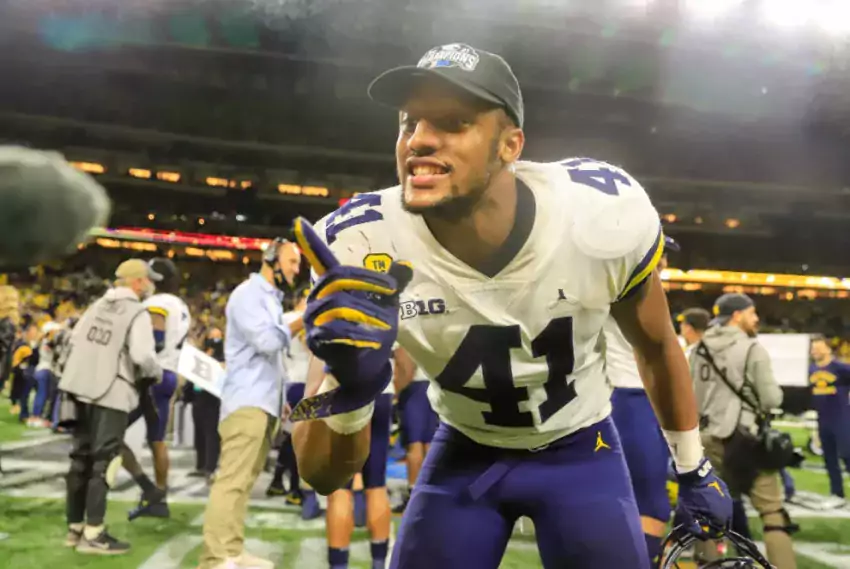
The defensive UFR was getting a little long so I thought I might pop out a chunk about Iowa’s heavy formation package, why Michigan was getting beat by it earlier in the game, how they adjusted, and how they caught Iowa trying to take advantage.
So Iowa finally has the ball moving after a stretch of 20/22 unsuccessful offensive plays, and gets to the Michigan 8 yard line, with 4th down and 3. Michigan broke through last drive to make it 21-3, and this drive has consumed almost 8 minutes of the 3rd quarter, so Iowa has to score to avoid going into the 4th quarter down three scores without the ball.
This was the result:
Let’s talk about how they did that.
[After THE JUMP]
We complete our Pulling Mike Schofield trilogy with a reason he may have been so eager to get outside on the play action Tacopants interception: he spent the week getting coached up on getting outside.
You might remember last week's complaining about rollouts that only seemed to get Denard pressured. Borges attributed some of this to "protection." Those issues were on the pulling guard, who twice saw two opponents coming up at Denard, slowed up in a moment of indecision, and blocked no one. Once this was Schofield; once it was Omameh. Schofield's moment of indecision:
Denard had to pull up; he threw off his back foot and the ball sailed over Koger's head.
One week later Michigan went easy on the rollouts so those edge guys aren't so eager to get outside. Their first of the game came deep into Michigan's second drive. Hopkins picked up a questionable holding call on first down and Gallon got eight of that back on a throwback screen, setting up second and twelve from the Northwestern 44.
Michigan comes out with two TEs again, this time in a balanced formation. Northwestern undershifts their line and leaves a strongside linebacker to the outside.
Michigan runs a play action with a mesh point and Schofield pulling across the formation.
By the time the mesh passes, ludicrously aggressive Northwestern linebackers are ludicrously aggressive. The MLB threatens to shoot up in the gap to the outside as Denard pulls.
This time instead of being hesitant, Schofield deepens his pull:
He's moving away from the LOS, and he's not worried about anyone except the backside DE. As Denard sprints out to the corner he makes contact…
And seals the guy. Linebackers can blitz all they want now.
They aren't catching Denard.
He would pick up eight yards before running out of bounds; three plays later Schofield zoomed outside on the Tacopants INT.
Video
Interesting Items
This is a bit easier for Schofield. On the Minnesota play there is a second guy scraping to the outside who he has to deal with. Here the outside guy is the outside guy and that is that.
This is still an obvious coaching point for the week. Schofield is headed hell or high water for the corner, not paying attention to anything that may show inside of him and focused on getting that outside guy sealed. As soon as that guy declares himself the contain man Schofield is directed to lock in and get outside of him.
I would not be surprised if the obvious coaching point was in some way responsible for Schofield getting too far outside on the Tacopants INT. It's a play action pass on which he is pulling a week after having the thing that happened against Minnesota happened—negative reinforcement—and three plays after the above play happened—positive reinforcement.
Schofield's in a tough spot as the designated backup at every position except center. He should be the top backup tackle, full stop, and only pull rarely (to date tackles only pull on some outside power plays and the sprint counter). Instead he's starting at guard and having a lot of very complicated things to do on a regular basis.
It's interesting that Michigan chose to pull him over and over despite his relative inexperience. Have they lost faith in Omameh's pulling to the point where they won't run behind Lewan, the most grinding of their OL? Is it because Denard is more of a threat rolling out to his right? Something in Northwestern's defense? I don't know.
This is a pretty impressive drop from Northwestern's #51. On the video it's clear he's steaming towards the LOS, reads what's going on, and drops into Koger's route. Without that Robinson can toss it to him for what looks like a certain first down.
When Michigan can manage this seal good things will happen. I'm not sure they'll be able to consistently. When they can Denard on the edge with receivers is going to equal big gains. The problem with the rollouts against Minnesota was they never got that edge.
That seems like something a defender can force by getting upfield far enough that he won't be sealed. Shooting the gap between a guy maintaining leverage and pressure from the inside is a potential sack. So you have to have something in your arsenal that makes the guy think twice. Not sure what that is; maybe Borges does.
[Editor's Note: I was going to do a jet sweep post but got beaten to it by BWS. His conclusion is pretty harsh to Demens, and some of that is deserved. I don't see that as a specifically Demens problem, though. EMU used a ton of formations, unbalanced lines, presnap motion, and wholesale realignments to get Michigan's D out of position and confused. It worked. It worked on Demens and it worked on large chunks of the rest of the D. I think they're confused as a group.
That taken care of I'll move on to one of EMU's completed passes, which answers a question from earlier in the year.]
In the first week of the season we discussed Michigan's End Man On The Line Of Scrimmage (EMLOS is the commonly accepted jargon) and how his performance was hurting Michigan against power runs, particularly the counters that both WMU and Notre Dame used to good effect.
Part of that discussion was about how much Brennen Beyer was at fault for getting way upfield on our first example. Beyer was sent on a blitz, ended up three yards in the backfield, and made it difficult for Kenny Demens to close down a major hole. Demens lost contain, compounding matters. How much of that was on Beyer?
I thought the answer was "quite a bit" and the way Michigan handled a particular play-action showing the same counter action seems to confirm. It's the first quarter and EMU is on its second drive. They've got a first and ten. They line up in a three-wide shotgun with two backs; Michigan aligns in the under.
On the snap two things are apparent based on the Michigan line: 1) Jibreel Black v(top of line) is dropping off into a short zone and Jake Ryan (bottom) is blitzing as the rest of the line slants left:
EMU is pulling the backside G; the RB is taking a counter step, and the other RB is coming down the line to block. This is a close analogue to the Beyer counter. You'll notice that both linebackers are still waiting.
Here's how Ryan handles this:
LEFT: he reads the pulling OL.
MIDDLE: he flattens his approach and starts coming down the line.
RIGHT: he's in the running lane playside of the block, not kicked out.
Here's Beyer vs Ryan:
Beyer is three yards upfield. Ryan is two. You can't tell this in the stills but Ryan's momentum is also much better. He is heading down the line and can impact a blocker with force. Beyer had to come to a full stop and redirect. He did that impressively; it was not enough.
Move Beyer a yard towards the LOS in the left frame and he is either making a tackle for no gain or picking off the other blocker, leaving the RB for an unblocked Demens. Look at the distance between the DE/LBs and the DTs. Even though RVB is fighting playside in the left frame and slanting away from the play in the right, the gap is much larger in the former. Win for Ryan.
Great! Except the tailback doesn't have the ball.
Nuts.
Gillette rolls out as Ryan comes underneath the tackle and three WRs release to the roll side:
Ryan's there to provide some token pressure but it's not enough; a WR running deeper than Demens and Gordon finds a window. Gillette throws…
…for a nice gain.
Video
Items of interest
Just because you're blitzing doesn't mean you don't have keys. My assumption is that Ryan is the guy doing what the coaches want here. He's got a year of experience, Michigan's been burned by this before and probably made a point of it in film study, and he's playing instead of Beyer (mostly).
You're sent on a blitz and get no resistance at all? Check for a pulling OL and get inside of him.
Just because there's obviously a key here doesn't mean there aren't more. The RB's second step here should be a giveaway that this is not a run play. My guess at Ryan's thought process:
- BLITZ WOO crap check the…
- Pulling G. Have to get inside pulling G to occupy blockers, restrict hole.
- Pulling G.
- D'oh.
- Token, too late edge pressure.
My guess at the ideal thought process:
- I have been assigned a blitz. Let's soberly check the…
- Pulling G. Have to get inside pulling G to occupy blockers, restrict hole. Hmm, maybe I should check the…
- Running back. He is past the mesh point but not following the pulling guys.
- ALERT
- EDGE PRESSURE WOO
"Football is hard." -psychology majors who used to be pre-med
I'm not too bothered by the hole in the zone. Once Ryan loses the edge there that's a lot of time for the QB to sit and wait for his WR to run his way into an inevitable gap. I guess you could blame either Gordon or Demens, probably Gordon. He could sink back into the route by reading the QB's eyes and either get a PBU/pick or, more likely, force a less-damaging dumpoff to the underneath receiver.
That seems like Advanced Zone Mechanics 486, though. That's a place to get to eventually.
Kovacs is the free safety. Gordon/whoever rolls down into the box far more often than Kovacs does and it's almost always Kovacs who's coming down to fill against WRs when completions are made.
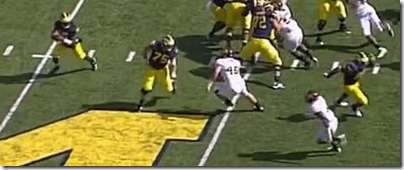
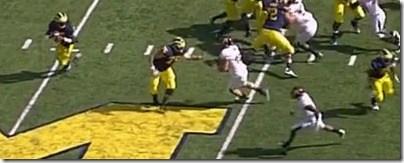
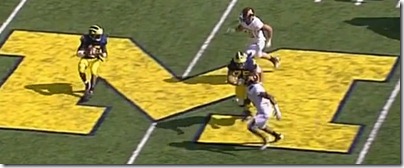
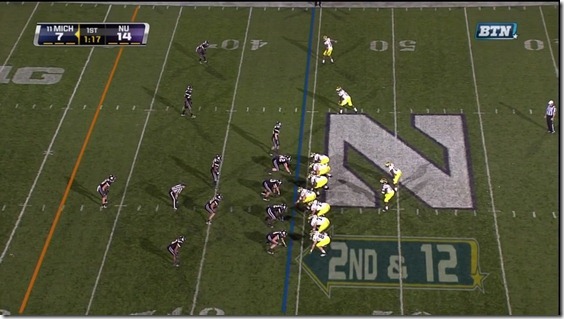
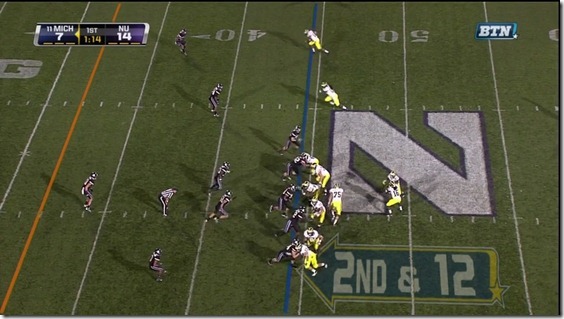
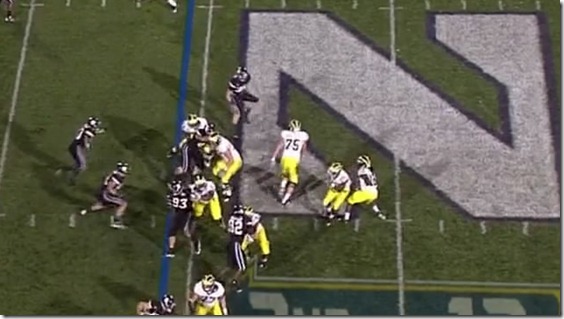
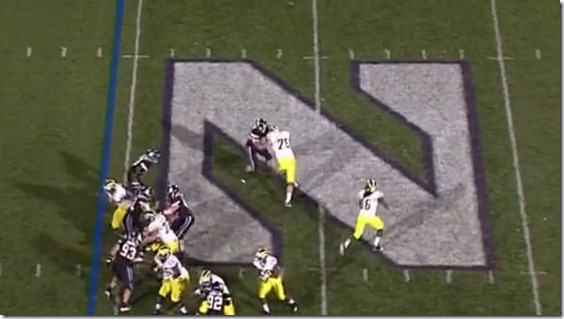
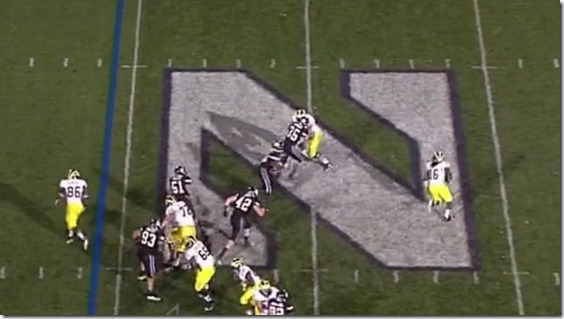
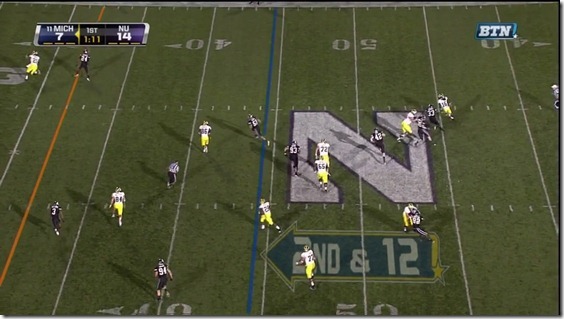
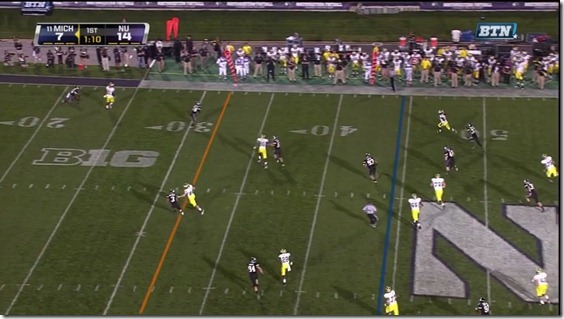
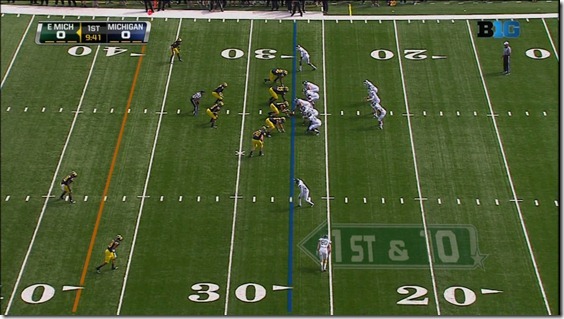


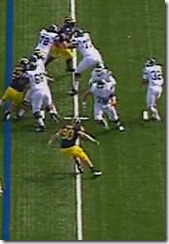

![counter-not-so-much-4_thumb[1] counter-not-so-much-4_thumb[1]](https://mgoblog.com/sites/mgoblog.com/files/counter-not-so-much-4_thumb1_thumb.jpg)


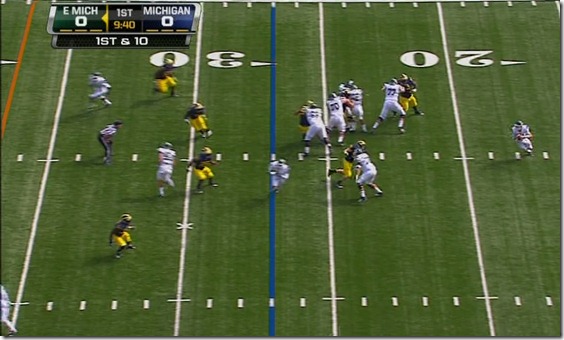
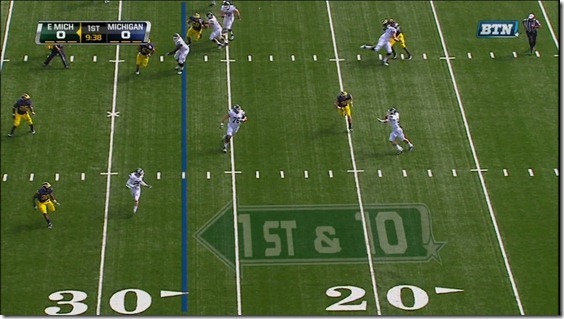
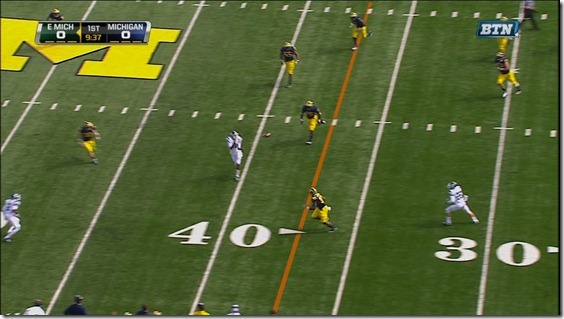
28